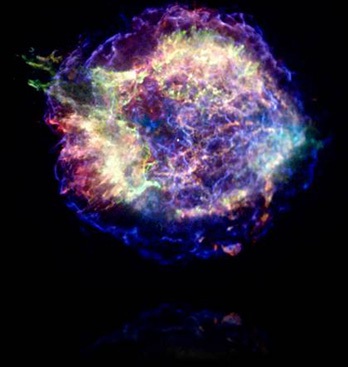
There are several myths related to constellations and some of them have stories associated with it. However, most of these stories may determine the position of these constellations. The constellation Cassiopeia is one such example. Traditionally it is known as Schedar and is derived from an Arabic word which means ‘breast’. Basically the star’s position marks queen Cassiopeia’s heart. A constellation in the northern hemisphere, it was first charted by the Greek astronomer Ptolemy in the 2nd century. It represents the mythical kingdom of Ethiopia. The star was used as a navigation reference by the astronauts. It comes from the Perseus family of constellations and can be seen in the month of November. Let us discuss Cassiopeia in detail.
Cassiopeia is known for its W shape formed by five of its major stars, they are:
- Schedar or Alpha Cassiopeiae: It is an orange giant suspected to be a variable star. Sometimes called as Shedir, its magnitude differs on the photometric system that is used and ranges between 2.20–2.23. It is approximately 228 light years distant from the earth.
- Caph or Beta Cassiopeiae: It is a sub–giant or a giant star that belongs to the spectral type F2 III–IV. It is also the 12th brightest star in the sky. Classified as a Delta Scuti type variable, it is brighter than Altair, which is the brightest star in the constellation Aquila. With a mean apparent magnitude of about 2.27, it lies approximately 54.5 light years distant.
- Gamma or y Cassiopeiae: It is not only the central star of this constellation but also the brightest one. As the star rotates very rapidly and bulges outward along the equator, a ‘decretion’ disk of lost mass and material forms around the star. This leads to the fluctuations in luminosity. With a luminosity of about 40,000 times than that of the Sun, it has about 15 solar masses and hence it exhibits irregular variations in brightness. Its magnitude ranges between 2.20 and 3.40 and is about 610 light years distant from the earth.
- Ruchbah or Delta Cassiopeiae: It is an eclipsing binary star. It is traditionally derived from the Arabic word rukbah, meaning ‘the knee’. This star is also known as Ksora. Belonging to the spectral class A5, it is the fourth brightest star in the constellation. Its magnitude varies between 2.68 and 2.74 and is about 99 light years away from the earth.
- Segin or Epsilon Cassiopeiae: This is a bright blue–white giant. It is notable for showing extremely weak spectral absorptions of helium. About 2,500 times more luminous than the sun, the estimated age of the star is about 65 million years. With an apparent visual magnitude of about 3.34, it is approximately 440 light years distant from the earth.
The other notable stars include Achird or Eta Cassiopeiae, Zeta Cassiopeiae, Rho Cassiopeiae and V509 Cassiopeiae.
Of the numerous deep sky objects of Cassiopeia, two are noteworthy:
- Messier 52: It is an open cluster estimated to be around 35 million years old. It has an apparent magnitude of about 5.0 and is approximately 5,000 light years distant.
- Messier 103 or NGC 581: This is another open cluster containing 172 stars. It lies nearly about 10,000 light years from the earth. The estimated age of the cluster is about 25 million years.
A few other deep objects include:
- Cassiopeia A: It is a supernova remnant and is known for being the brightest astronomical source in the sky. It was the first and the strongest radio sources to be discovered in 1947 outside the solar system. Also, it has a temperature of about 50 million degrees Fahrenheit.
- The Pacman Nebula or the NGC 281: It contains ionized atomic hydrogen in huge amount which is lit by the ultraviolet light of young, hot blue stars. It is said to be a large cloud of gas in which the star formation has recently taken place. Due to its resemblance to the character from a popular video game, it was nicknamed Pacman Nebula. It is about 9,500 light years away from the earth.
- The White Rose cluster or the NGC 7789: This is another open cluster, also known as Caroline’s Rose as the loops of stars in it resemble the pattern of the rose petals. It has an apparent magnitude of about 6.7 and is approximately 7,600 light years distant from the earth.
- Caldwell 18 or NGC 185: The star is a dwarf spherical galaxy and is a satellite galaxy of the Andromeda Galaxy, forming a physical pair with NGC 185. This NGC 185 contains young clusters of stars and shows evidences of stars that were formed in the cluster recently.
- Caldwell 17; It is another dwarf spherical galaxy. It is a satellite galaxy of the Andromeda Galaxy and a member of the Local Group of galaxies. With an apparent magnitude of about 10.5, it is approximately 2.53 million light years distant from the earth.

Seen at latitudes between +90° and -20°, it lies in the first quadrant of the northern hemisphere.
It occupies an area of 598 square degrees, making it the 25th largest constellation in the night sky. It is roughly 19 light years distant from earth and is hence, a much closer constellation to the earth even though the star is farther away to about 442 light years distant.
According to a mythological story, Cassiopeia was the wife of King Cepheus of Ethiopia. As she was very beautiful, she boasted of her beauty. Once while doing so, she called herself more beautiful than the Nereids. Nereids were the 50 sea nymphs, sons of Titan Nereus. Angry by Cassiopeia’s comment, they appealed to Poseidon, one of the twelve Olympian of the pantheon in Greek mythology. As a punishment, Cassiopeia was married to Amphitrite, one of the nymphs. Later, she was placed in the sky by Poseidon and was fated to circle the celestial pole forever. Cassiopeia is represented on her throne, combing her hair. Half of her year is spent upside down in the sky as a punishment.
Cassiopeia is surrounded by constellations such as Andromeda, Camelopardalis, Cepheus, Lacerta and Perseus.


